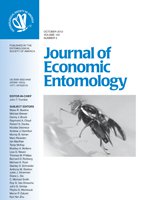Field trials were conducted at Rosemount, MN in 2009 and 2010, to measure pollen movement from Bt corn to adjacent blocks of non-Bt refuge corn. As the use of Bt corn hybrids continues to increase in the United States, and new insect resistance management (IRM) plans are implemented, it is necessary to measure the efficacy of these IRM plans. In Minnesota, the primary lepidopteran pests of corn include the European corn borer, Ostrinia nubilalis (Hübner) and corn earworm, Helicoverpa zea (Boddie). The primary IRM plan in transgenic corn is the use of hybrids expressing a high dose of insecticidal proteins and an insect refuge containing hybrids not expressing insecticidal proteins that produce susceptible insects. Wind-assisted pollen movement in corn occurs readily, and is the primary method of pollination for corn. The combination of pollen movement and viability determines the potential for cross pollination of refuge corn. In 2009 and 2010, cross pollination occurred with the highest frequency on the north and east sides of Bt corn fields, but was found at some level in all directions. Highest levels of cross pollination (75%) were found within the first four rows (3 m) of non-Bt corn adjacent to Bt corn, and in general decreasing levels of cross pollination were found the further the non-Bt corn was planted from the Bt corn. A mosaic of Bt cross-pollinated kernels was found throughout the ear, but in both years the ear tip had the highest percentage of cross-pollinated kernels; this pattern may be linked to the synchrony of pollen shed and silking between Bt and non-Bt corn hybrids. The dominant wind direction in both years was from WNW. However, in both years, there were also prevailing winds from SSW and WSW. Further studies are needed to quantify Bt levels in cross-pollinated kernels, measure the Bt dose of such kernels and associated lepidopteran pest survival, and measure the impact of Bt pollen on lepidopteran pests, particularly when considering the seed mixture refuge configuration.
How to translate text using browser tools
1 October 2012
Bt Pollen Dispersal and Bt Kernel Mosaics: Integrity of Non-Bt Refugia for Lepidopteran Resistance Management in Maize
Eric C. Burkness,
W. D. Hutchison
ACCESS THE FULL ARTICLE
It is not available for individual sale.
This article is only available to subscribers.
It is not available for individual sale.
It is not available for individual sale.

Journal of Economic Entomology
Vol. 105 • No. 5
October 2012
Vol. 105 • No. 5
October 2012
Bacillus thuringiensis
Helicoverpa zea
Ostrinia nubilalis
refuge




